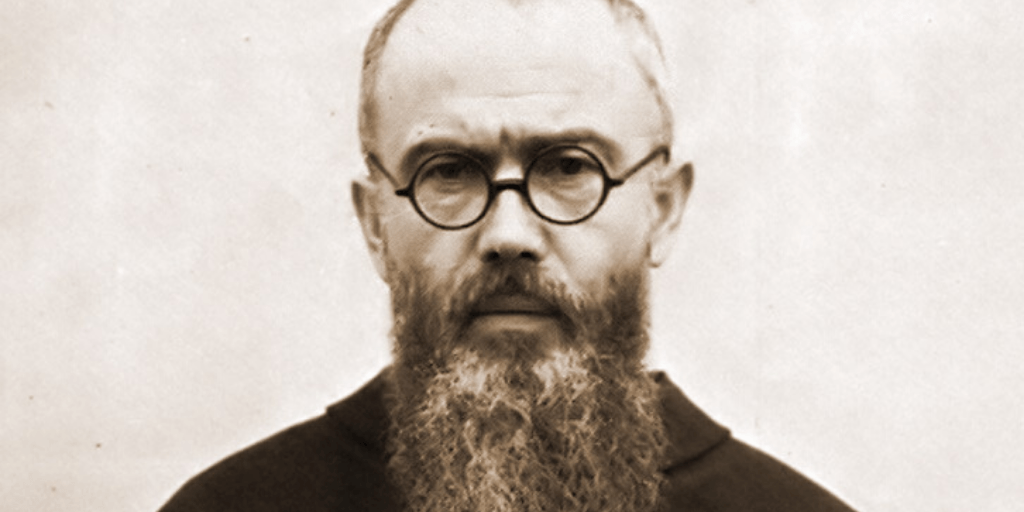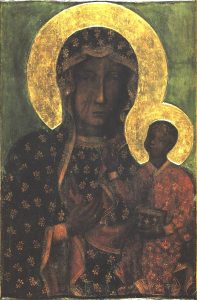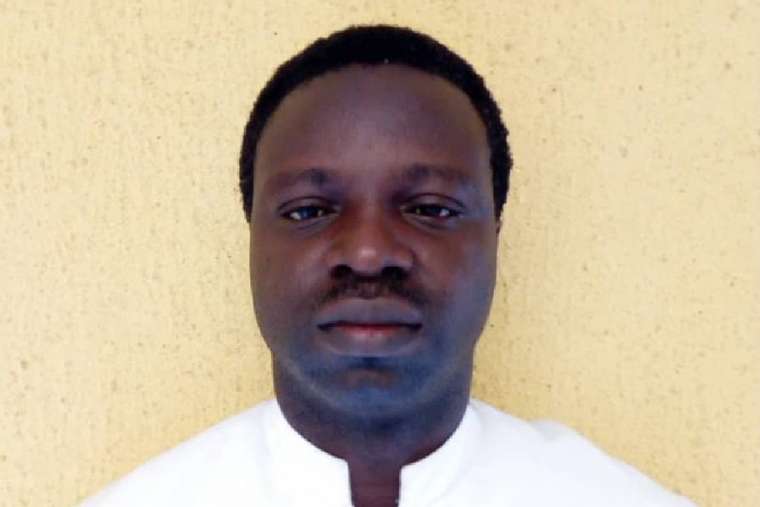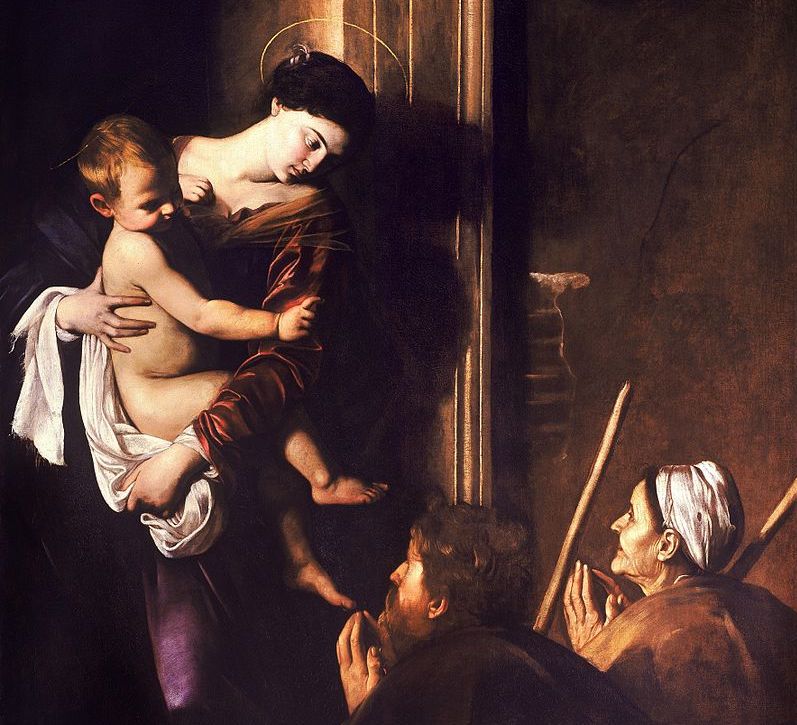Shock.
They all felt it as they watched him step out of the line of prisoners and saw him take the hand of the torturer in his. They watched him bow and press his parched lips against the monster’s pallid flesh.
They saw the Nazi known as The Horror of Auschwitz quickly yank his hand away, recoiling from that brief, chaste kiss.
The tension of that surreal moment reached a fever pitch.
Then he softly spoke, “I am a Catholic priest.”
It was the end of July 1941 when the man of God pointed at the stranger whose life he had determined to save.
And in that instant, the most improbable words were spoken. They seemed to defy logic. Words they would never forget.
“Let me take his place.”
His stunning request rendered everyone silent.
“I am old.”
The priest was 47.
Still pointing, he said, “He has a wife and children.”
Silence.
Lagerfürer Karl Fritzsch narrowed his eyes and regarded the frail, graying prisoner who had insolently touched him. He blinked, trying to make sense of his words.
He was in the middle of meting out punishment because a prisoner had escaped from the barracks. Fritzsch had randomly selected ten men to be starved to death to deter the others.
Now this priest was volunteering to take the place of one of them.
Fritzsch turned his gaze from the priest to the condemned man standing at the end of Block 11. The one who had cried out in despair, “I pity my wife and children whom I am about to orphan!”
The Nazi felt disgusted. He was the acting commandant at the death camp. He saw the prisoners as he saw all people, as objects to be exploited and destroyed. It made no difference to him which ones lived and which ones died.
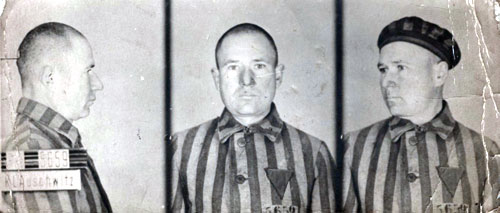
The priest stubbornly repeated himself, “I’m a Catholic priest from Poland; I would like to take his place because he has a wife and children.”
Fritzsch’s contempt for the priest was displaced by the look of terror he saw on the condemned man’s face. That decided the matter. In his psychopathic mind, Fritzsch imagined it would torment the prisoner to live with the knowledge that a Catholic priest had died in his place.
The Nazi couldn’t help but laugh.
The prospect of the man’s incessant suffering gave the torturer a sadistic thrill, and so he waved his hand – the hand the priest had kissed – and granted the absurd request.
The condemned man was pulled out of the line, and the priest took his place with the other doomed captives. Together they marched into the darkness of the prison cell to embrace the one the founder of the Franciscan order called Sister Death.
All praise be yours, my Lord, through Sister Death,
From whose embrace no mortal can escape.
Woe to those who die in mortal sin!
Happy those she finds doing your will!
From the ‘Canticle of Brother Sun and Sister Moon of St. Francis of Assisi’.
Inmate Number 16670
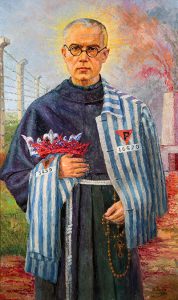
As the heavy iron door was closing, a Nazi soldier snickered and told them, “You will wither like tulips!”
A cacophony of desperate, hysterical screams echoed through the prison from the men trapped in the so-called “hunger bunker.”
In a neighboring cell, prisoners who were spared could hear their frantic cries. So could the Nazi guards who were either indifferent or amused.
The man whose life was spared was called Franciszek Gajowniczek. Tears of awe and relief were streaming down his cheeks and he demanded to know the name of the stranger who had bravely insisted on taking his place. One of the other captives whispered that the priest’s name was Father Maximilian Kolbe.
Five years later, when the Nazis were defeated, Gajowniczek gave this account of what had transpired:
“At first, the prisoners were screaming out of despair, blaspheming against God. Later, under Father Kolbe’s influence, they began to pray and sing songs to the Holy Mother. The priest gave them comfort, he was listening to their confessions and preparing them for death.”
The doomed men lifted their voices in songs of praise. They rang out in the corridors of the death camp, in the ears of their fellows and captors, their faith an act of defiance and victory. One by one, over the brutal days that followed, their voices faded away until the singing finally stopped.
After two weeks without food or drink, Father Kolbe shocked the oppressors once again. When they opened the door to Cell 11 on August 14, 1941, he and three of the other condemned men were still alive!
But the Nazis required the torture chamber for a new group of death row inmates and so they decided to kill the surviving prisoners by lethal injection. They sent Funktionshäftling Hans Bock to administer phenol. When they came for him, Father Kolbe is said to have calmly raised his arm to receive the toxic shot that cruelly ended his earthly sojourn.
Thus, a long ago promise Our Lady made to him was fulfilled.
No one in the world can change Truth. What we can do and should do is to seek truth and to serve it when we have found it. The real conflict is the inner conflict. Beyond armies of occupation and the hetacombs of extermination camps, there are two irreconcilable enemies in the depth of every soul: good and evil, sin and love. And what use are the victories on the battlefield if we are ourselves are defeated in our innermost personal selves?
Saint Maximilian Kolbe, O.F.M. Conv.
The Saint of Auschwitz
Saint Maximilian Kolbe O.F.M. Conv. was a Polish Catholic friar, martyr and the most influential Mariologist of the 20th century.
He was a pioneering multimedia evangelist. Saint Maximilian was the founder and publisher of the Knight of the Immaculate. During his tenure, the magazine had over 750, 000 readers. In addition to this, he also operated an independent radio station called SP3RN. It is still operating today under the name Radio Niepokalanów.
Saint Maximilian founded two monasteries in honor of the Virgin Mary: Niepokalanów in Poland and Mugenzai no Sono in Japan. He hoped to establish a third in India, but this never came to fruition due to the outbreak of World War II. Under his stewardship, the Niepokalanów monastery in Poland became the largest in the world at that time.
In his homily at the beatification of Saint Maximilian, Pope Paul VI said, “The Church recognizes in him an exceptional figure, a man in whom God’s grace and the soul have so interacted as to produce a stupendous life. Anyone who observes it closely discovers this symbiosis of a dual operating principle, the divine and the human. One is mysterious, the other can be experienced; One is transcendent but interior, the other natural but complex, and expanded to the point of reaching that extraordinary image of moral and spiritual greatness that we call holiness.”
Fr. John Hardon, S.J. described him as a “zealous promoter of the veneration of the Immaculate Mother of God.”
For this reason, Saint Maximilian is called the Apostle of Consecration to Mary.
Pope Saint John Paul II said of him, “By laying down his life for a brother, he made himself like Christ.”
“Hate is not a creative force. Love is a creative force.”
Saint Maximilian Kolbe, O.F.M. Conv.
Saint Maximilian’s Childhood Years
He was born Rajmond Kolbe on 8 January 1894 in Zduńska Wola, Kingdom of Poland, Russian Empire to Maria (née Dąbrowska) and her husband Julius Kolbe, an ethnic German. He was the second of their five sons: Franciszek Kolbe (1892), Walenty Kolbe (1897-1898), Jósef Kolbe (1896-1930), and Antoni Kolbe (1900-1904). His two younger brothers Walenty and Antoni died in early childhood.
His parents were weavers. They were hard-working, disciplined, and devout. Not long after his birth, the Kolbe family settled in Pabiance. His mother supplemented the family income by taking extra work as a midwife.
His parents were known for their deep faith and love of country. They raised their children in these traditions.
His mother inspired Saint Maximilian and his brothers’ devotion to the Virgin Mary. His mother taught her sons to recite The Angelus, the Holy Rosary, and the Litany of the Blessed Virgin Mary daily.
At the time, there were bitter political divisions in Poland, which was occupied by Russia, Prussia, and Austria. The people longed to be free of their oppressors.
Throughout his early years, Saint Maximilian venerated Our Lady of Czestochowa, also known as the Black Madonna of Czestochowa, the patroness of Poland.
Inspired by his sense of chivalry, he hoped that knights would reclaim the motherland in honor of the Immaculate Virgin Mary.
“He is a genius. A genius in mathematics. A genius in physics.”
Fr. Lucian Krolikowski
Maximilian Kolbe’s Vision of Our Lady
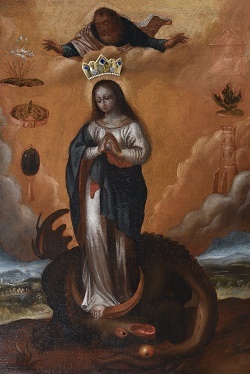
Saint Maximilian was a brilliant and inquisitive child, but he was also mischievous.
One day his behavior frustrated his mother, and she admonished him harshly. She asked what he thought would become of him if he persisted in his waywardness.
Young Saint Maximilian tearfully put his mother’s question to Our Lady in prayer.
In 1906 at the age of twelve, he had a vision of the Immaculata.
Saint Maximilian recalled, “That night, I asked the Mother of God what was to become of me. Then she came to me holding two crowns, one white, the other red. She asked me if I was willing to accept either of these crowns. The white one meant that I should persevere in purity and the red that I should become a martyr. I said that I would accept them both.”
The young saint demonstrated great intellectual ability. He was especially gifted in the sciences and mathematics.
Fr. Lucian Krolikowski, who lived with St. Maximilian for three years, recalls, “In 1907, he had already [worked out] how to shoot a rocket to the moon, what kind of thrust [was required] to shoot it.”
Around that time, two Conventual Franciscans began a parish mission at the church in Pabianice. Saint Maximilian identified with the Franciscan ideals. In 1907, at the age of thirteen, he and his younger brother Jósef joined the Order of Friars Minor Conventual seminary in Lwów.
That night I asked the Mother of God what was to become of me.
Saint Maximilian Kolbe, O.F.M. Conv.
The Education of Maximilian Kolbe
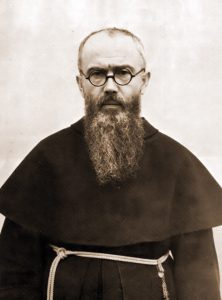
The Order of Friars Minor Conventual is a Catholic branch of the Franciscans, founded by St. Francis of Assisi in 1209.
During the review process of Saint Maximilian’s application by the Order, there was resistance from one of his teachers.
Fr. Lucian recalls, “They discussed each application, and when it came to Rajmond Kolbe, one of the professors stood up and said, ‘It will be a loss for the world to put him in the [seminary]. It would be a loss for Poland. Because he is a genius: a genius in mathematics and a genius in physics. I am his professor and I cannot follow his thoughts. He is so bright. He could be another Copernicus or Galileo or Newton, so it’s better to send him to the university, not to seminary.’
“And our Provincial answered him and said, ‘I agree. He might be a genius, as you say in mathematics and physics. But I will tell you that in spirituality we have geniuses also and we call them saints!”
Saint Maximilian joined the novitiate of the Conventual Franciscans on September 4, 1910. He was given a Franciscan habit and the name Maximilian – the greatest – by his superiors as an expression of their faith in his abilities.
His younger brother Jósef followed him into the Order and became Friar Alphonse.
When he received the news that he was to be named Maximilian, he said, “Hurrah! I want to be the greatest! But in what? In loving people and loving God!”
At seminary, Saint Maximilian distinguished himself as a student, leader, and organizer.
He spent many hours in prayer before the Most Blessed Sacrament daily. Devotion to the Blessed Virgin Mary is central to Franciscan life and he felt at home.
Studies in Rome
In 1912, Saint Maximilian was sent to the Pontifical Gregorian University in Rome. He professed his final vows in 1914, adopting the additional name of Maria.
He earned the first of his two doctorates in philosophy in 1915 at the age of 21. Upon his graduation, he began his doctoral research in theology at the Pontifical University of St. Bonaventure.
While in Rome he contracted chronic tuberculosis. The disease caused him to cough up blood and destroyed one of his lungs. It would plague him for the rest of his life.
The illness systematically weakened his body but not his mind. The young friar remained determined, purposeful and enterprising despite his debilitating condition.
The Demonstration in St. Peter’s Square
In 1917, St. Maximilian witnessed the Freemason bicentennial celebration in St. Peter’s Square. He saw them demonstrate against Pope St. Pius X and Pope Benedict XV carrying banners with the words, “Satan Must Reign in the Vatican. The Pope will be his slave.”
Saint Maximilian wrote about the incident, “They placed the black standard of the ‘Giordano Brunisti’ under the windows of the Vatican. On this standard, the archangel, St. Michael, was depicted lying under the feet of the triumphant Lucifer. At the same time, countless pamphlets were distributed to the people in which the Holy Father was attacked shamefully.”
After witnessing the demonstration, Saint Maximilian added the following lines to the Miraculous Medal prayer:
“O Mary, conceived without sin, pray for us who have recourse to thee. And for all those who do not have recourse to thee; especially the Masons and all those recommended to thee.”
THE MILITIA OF THE IMMACULATE
Three days after the Miracle of the Sun was witnessed by over 70,000 people at Fàtima, St. Maximilian obtained permission from his superiors at the Conventual Franciscan Collegio-Serafico in Rome to establish the Militia Immaculatae (M.I.) or the Knights of the Immaculate on 16 October 1917.
He drafted the statutes of the sodality and together with the other founding members, he consecrated himself to Our Lady.
They were:
- Father Joseph Pal
- Friar Anthony Glowinski
- Friar Jerome Biasi
- Friar Quiricus Pignalberi
- Friar Anthony Mansi, and
- Friar Henry Granata
Approval from the Holy Father was granted through Archbishop Dominique Jacquet, O.F.M. Conv. They set out to work for the conversion of sinners and opponents of the Catholic Church through the intercession of the Immaculate Virgin Mary.
Saint Maximilian wrote:
“These men without God find themselves in a tragic situation. Such implacable hatred for the Church and the ambassadors of Christ on Earth is not in the power of individual persons, but of a systematic activity stemming in the final analysis from Freemasonry. In particular, it aims to destroy the Catholic religion. Their decrees have been spread throughout the world, in different disguises. But with the same goal – religious indifference and weakening of moral forces, according to their basic principle – ‘We will conquer the Catholic Church not by argumentation, but rather with moral corruption.’”
Saint Maximilian was a chess master who was considered unbeatable by his peers. He viewed the Holy Rosary as a weapon and the Miraculous Medal as ammunition. He dedicated himself to raising an army of spiritual warriors and he considered the Militia Immaculatae his check mate against the adversary.
Modern times are dominated by Satan and will be more so in the future. The conflict with hell cannot be engaged by men, even the most clever. The Immaculata alone has from God the promise of victory over Satan.
Saint Maximilian Kolbe, O.F.M. Conv.
Return to Poland
Saint Maximilian returned to Poland to teach as a professor of history, philosophy and sacred scripture at the seminary in Krakow in 1919.
However, his health deteriorated and in 1920 Saint Maximilian suffered from a serious bout of tuberculosis. He underwent treatment and remained in a sanatorium at Zakopane until April 29, 1921. The doctors gave the prognosis that he had an incurable disease and had only a few months to live.
Saint Maximilian returned to the friary in Krakow and completed his second doctorate in theology in 1922. The Militia Immaculatae was canonically established as a Pious Union in the same year and 1926, it received the status of a Primary Union from Pope Pius XI.
He entered a period of severe spiritual testing when he returned to Poland as his fellow friars took advantage of his vulnerability due to his disease. They regularly ganged up on him and ridiculed his goals, his difficulty moving and breathing. They were unsupportive of his work. Saint Maximilian quietly endured their bullying. No matter how bad it got, he kept the faith.
We will do very much more if we are plunged into interior and exterior darkness, filled with sorrow, weakness and exhaustion, without consolation, persecuted at every step, surrounded by continual failures, abandoned, ridiculed, scoffed at, as was Jesus on the Cross; provided that we want by all means to draw men to God, through the Immaculata.”
Saint Maximilian Kolbe, O.F.M. Conv.
The Knight of the Immaculate
Saint Maximilian requested permission from his superior to publish a magazine about devotion to the Immaculate Virgin Mary. This caused a lot of discussion as he was very ill and not expected to live long. What point was there for an impoverished fraternity to invest in a publication by a dying editor-in-chief?
Saint Maximilian was granted permission to publish, much to the astonishment of his peers, on the condition that he raise the capital to finance the publication himself.
He published 5000 issues of The Knight of the Immaculate and distributed by hand in the streets of Krakow. It was 16 pages of articles which he wrote himself. He had little support from him confreres who criticized nearly everything about his endeavor and called him “the dreamer.” But he did not let that stop him.
One day an American priest Fr. Lawrence Cyman visited the friary and Saint Maximilian’s brethren used the occasion to ridicule his efforts to publish The Knight. They made light of the fact that he used an old, worn printing press and that he was unable to finance the publication.
Fr. Cyman said, “My dear Fathers, instead of making fun of him, would it not be better to help him pay for the machine?”
The priest lead by example, and wrote a check to Saint Maximilian for the sum of one hundred dollars – a vast amount of money at the time.
The support of Fr. Cyman, turned Saint Maximilian’s situation around. He used the donation to improve the quality of the publication and expand the printing operation at Grodno, which soon had a growing number of subscribers.
We must first be Saints ourselves.
Saint Maximilian Kolbe, O.F.M. Conv.
Niepokalanów – The City of the immaculate
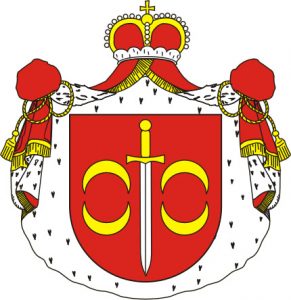
By 1927, the Knight of the Immaculate had 27, 000 subscribers and the operation had expanded to such an extent that more space was required.
Prince John Drucki-Lubecki owned a piece of land outside of Warsaw, which Saint Maximilian thought was ideal due to its proximity to the railway. The land was large enough for unlimited expansion.
Saint Maximilian met with the Prince on June 13, 1927. The negotiation for the property was fraught with difficulties as Saint Maximilian was unable to raise the amount of money the Prince was asking for the land.
The Prince agreed to reduce the price if the Order promised to say perpetual mass for him and his descendants. The Order refused and the property deal was about to collapse.
The Prince told Saint Maximilian to collect the large statue of the Virgin Mary the he had placed on the property. But the Saint asked the Prince to let the statue remain there for a while. After some time, the Prince came to the realization Saint Maximilian was merely an ambassador for the Virgin Mary. He agreed to Saint Maximilian’s terms and sold him the land.
When he came to Niepokalanów, he and his brethren consecrated the untamed land to the Immaculata with the words, “Take into your possession this field and this land.”
The principal reason for Niepokalanów is the sanctification of the brothers, our own sanctification. We must never forget this.
Saint Maximilian Kolbe, O.F.M. Conv.
Twenty two friars took up residence there. His brother Friar Alphonse was among them. Twenty were founding friars of the community. They helped transfer the heavy machinery from Grodno to Niepokalanów and helped to construct buildings.
Niepokalanów was modeled after Santa Maria degli Angeli (Saint Mary of the Angels) in Assisi, Italy, the most sacred place for members the Franciscan order.
In 1929, two schools of vocations opened in Niepokalaów. The brothers were taught to regard their work as prayer. Silence was interrupted by songs of praise and the brothers greeted each other with the name “Mary,”
His personal struggles with his health inspired an immense love of the sick in his heart. Saint Maximilian made it a priority to build a hospital at Niepokalanów. There he imitated Our Lady who ministered to the suffering Christ and the missions of mercy by Saint Francis of Assisi, taking time to visit the sick at the hospital.
Niepokalanów was seen by Saint Maximilian as the first of many Marian cities that would spread around the world. By 1930, the Knight of the Immaculate had 343 000 subscribers and was steadily growing.
Saint Maximilian was called to go on a mission abroad. Sadly, his brother Friar Alphonse contracted pneumonia. The Saint had a premonition of his brother’s death and found him asleep when he came to say goodbye to him.
Sleep, my dear brother. There was never a more merited rest in the service of the Immaculata! Farewell…who knows if we will see each other again on earth.”
Saint Maximilian Kolbe, O.F.M. Conv.
Mugenzai No Sono – The Garden of the Immaculate
On February 26, 1930, Saint Maximilian left Poland on a mission to Asia. He travelled with his fellow friars Zeno, Hillary, Severin, and Zygmund to China. When they arrived in Shanghai, they appealed to the bishop to establish a friary and a Chinese version of the Knight of the Immaculate.
The Bishop was not supportive but Saint Maximilian was undeterred. He had made the acquaintance of a wealthy Chinese entrepreneur Joseph Lo-Pa-Hong, a cradle Catholic. Mr. Lo-Pa-Hong furnished the Franciscans with a house and brothers Severin and Zygmund remained there to learn Chinese, while Saint Maximilian and the other brothers travelled to Japan.
When he arrived in Nagasaki on April 24, 1930, he was unwelcome. Bishop Hayasaka thought that Saint Maximilian’s ambitions were too fantastical and ordered him to leave. Saint Maximilian did not have money to return and the superior was afraid they would not able to cover his expenses if he stayed. The Bishop told him that he had no place for him and was only willing to take on a professor of philosophy and theology to which Saint Maximilian answered, “I have those two doctorates.”
The Bishop allowed him to stay on the condition that Saint Maximilian took up the teaching position at his seminary.
A month after landing in Japan, Saint Maximilian printed the first Japanese edition of Knight of the Immaculate. He had the text translated from Latin into Japanese and it became the first Catholic magazine ever printed in Japan. The Japanese edition of t The Knight of the Immaculate is called Seibo No Kishi.
His brother, Friar Alphonse, died of pneumonia in December 1930.
The missionaries were given a property near a cemetery for untouchables on the slopes of Mount Hikosan. There they constructed a second seminary. A larges statue of the Immaculata was placed on the highest point of the property overlooking Nagasaki. When Nagasaki was bombed World War II, Mugenzai No Sono was untouched.
The friars moved in to Mugenzai No Sono on May 16, 1931, where Saint Maximilian became the superior, a year after their arrival in Japan.
The Japanese version of The Knight became the largest Catholic publication in Japan with 50, 000 subscribers by 1933.
Saint Maximilian suffered a variety of health crisis in Japan. He developed boils, suffered from chronic fevers and terrible headaches. Nevertheless he persevered.
In 1933, Saint Maximilian was called back to Poland for a conference. Due to his poor health, he was replaced as superior at Mugenzai No Sono by his friend Fr. Cornelius Czupryk.
Father Maximilian returned to teaching theology in Japan and was appointed the International Director of the Militia Immaculatae. In this capacity, he travelled to India seeking to establish a third City of the Immaculate.
There he was welcomed by the Archbishop of Ernakulam, who enthusiastically supported his work and offered him land with a residence and church. Sadly, progress was halted by the outbreak of the Second World War. Many years later in 1981, two Franciscan friars from Malta established a Marian outpost in Chotty, Karala, India.
Saint Maximilian eventually returned to Poland from Japan. He told the brothers in the Order that he had experienced a revelation during his travels.
“He must have had a vision in Japan,” says Fr. Lucian Krolikowski, “Our Blessed Virgin Mary told him that he would be in Heaven. And he wanted to share this. He couldn’t stand to have this secret all alone. So he said to [the] friars, ‘I have been promised Heaven.'”
“We must not only work for Japan. What about China, India, Turkey, the whole Arab World, and the whole of Africa? All peoples must be led to Christ.
Saint Maximilian Kolbe, O.F.M. Conv.
The Saint of Auschwitz
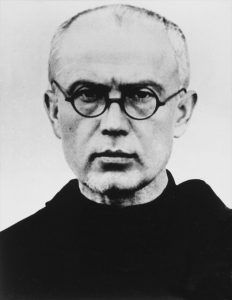
On December 8, 1938 the radio station made its first broadcast from the building constructed by Saint Maximilian and his brethren. Difficultuies arose as Freemasons in the government created legal red tape.
Approximately 2000 Jews took refuge at Niepokalanów during World War II where they were cared for by the friars. Saint Maximilian used his print and radio platforms to publish anti-Nazi reports. It is said that his work with The Knight spiritually edified Poland and prepared the people for the totalitarian onslaught of Nazi Germany.
On February 17, 1941, he and several friars at Niepokalanów were arrested by the Gestapo.
Upon his arrest, Saint Maximilian said, “Courage, my sons. Don’t you see that we are leaving on a mission? They pay our fare in the bargain. What a piece of good luck! The thing to do now is to pray well in order to win as many souls as possible.”
Saint Maximilian was detained at Pawiak Prison in Warsaw before he was transferred as a political prisoner to the German concentration camp Auschwitz on May 28, 1941. There he was assigned the inmate number 16670. He endured forced labor and was tortured. He was made to transport gravel to build a fence around the crematorium where the bodies of the prisoners were burned.
Saint Maximilian never wavered in his faith during his time at Auschwitz. He ministered to other inmates, heard their confessions and said Mass regularly. He was routinely beaten for saving his bread rations in order to give the Holy Eucharist to his fellow inmates.
Saint Maximilian died at 12.30 on August 14, 1941. Today he is best known for his act of heroic charity: volunteering to die in the place of a stranger – an imitation of Our Precious Lord, Jesus Christ.
Saint Maximilian’s body was cremated on August 15, 1941, on the feast day of the Assumption of Mary. His ashes were scattered at Auschwitz.
“I have been promised Heaven”
Saint Maximilian Kolbe, O.F.M. Conv.
Canonization
He was canonized by Pope Saint John Paul II on October 10, 1982. Because of Saint Maximilian’s extraordinary witness at Auschwitz, the scripture selected for the liturgy at his canonization was John 15:12-17:
“12 My command is this: Love each other as I have loved you. 13 Greater love has no one than this: to lay down one’s life for one’s friends. 14 You are my friends if you do what I command. 15 I no longer call you servants, because a servant does not know his master’s business. Instead, I have called you friends, for everything that I learned from my Father I have made known to you. 16 You did not choose me, but I chose you and appointed you so that you might go and bear fruit—fruit that will last—and so that whatever you ask in my name the Father will give you.17 This is my command: Love each other.”
“There is no greater love than this:
to lay down one’s life for one’s friends.”
John 15:12-17
legacy
The feast day of Saint Maximilian Kolbe is August 14. He the patron saint of drug addicts, political prisoners, families, journalists, prisoners and the pro-life movement.
Saint Maximilian’s legacy is vast and far-reaching. The seminaries, publication and radio station he founded are still thriving. Churches and schools around the world bear his name and teach his message of devotion the Immaculate Virgin Mary.
He is an icon of the Holocaust and the Second World War and his influence resonates today in the much of the post war ideology about human rights.
Frances Gajowniczek, the man who Saint Maximilian died for, traveled the world and told people about his extraordinary act of heroic charity. Gajowniczek was present at his beatification and canonization. Gajowniczek died at the age of 95.
Both Frances Gajowniczek and Prince John Drucki-Lubecki are buried in Niepokalanów, the City of the Immaculate.
A statue of St. Maximilian Kolbe was erected at Westminster Abbey in 1998.
The National Conference of Catholic Bishops of the United States declared Marytown in Libertyville, Illinois as a national shrine of St. Maximilian Kolbe.
Poland’s Senate declared 2011 as the year of Maximilian Kolbe.
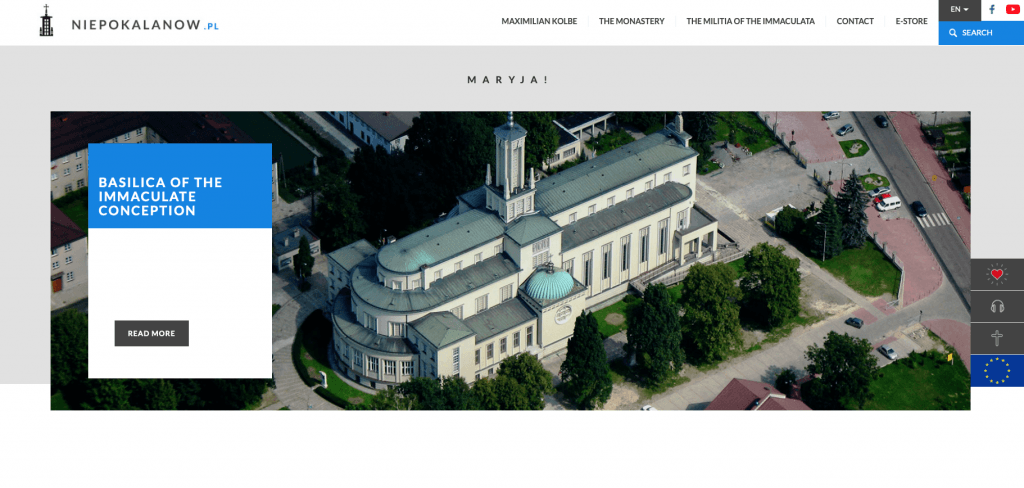
Bibliography
- Hardon, John A. “Maximillian Kolbe, Apostle of Mary.” Catholic Culture. Great Catholic Books Newsletter, 2003.
- Kalvelage, Francis Mary. Kolbe, Saint of the Immaculata. New Bedford, MA: Franciscans of the Immaculate, 2001. Page 33-34.
- Krolikowski, Lucian. ‘I Lived With St. Maximilian Kolbe.’ Franciscan Friars. 2015.
- Telewizja Polska S.A. “78 Years Ago St Maksymilian Kolbe Was Deported to Auschwitz.” (polandin.com). Published May 27, 2019. Accessed February 10, 2020.
- St. Maximilian Kolbe – Saint and Martyr of the Immaculate (1984 – 1941) – Franciscans of the Immaculate.
